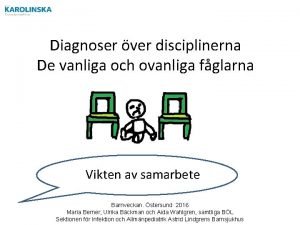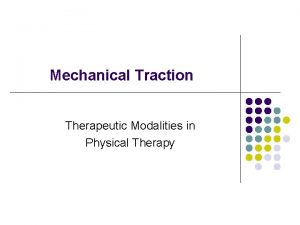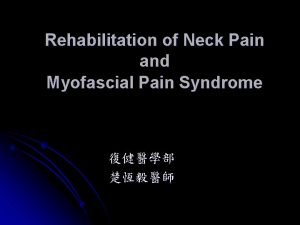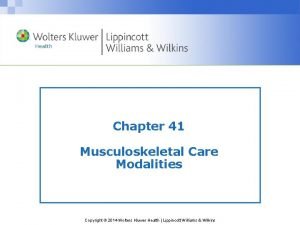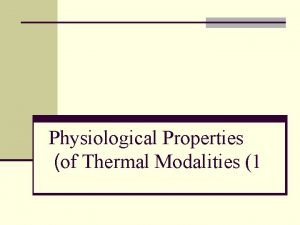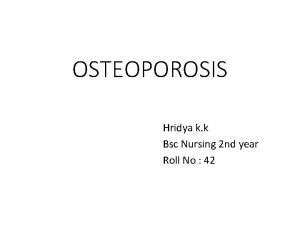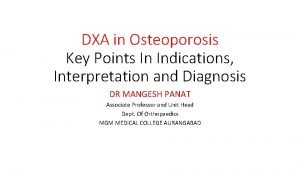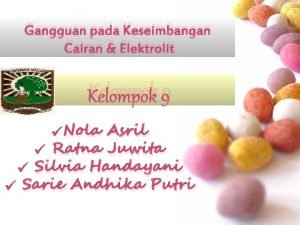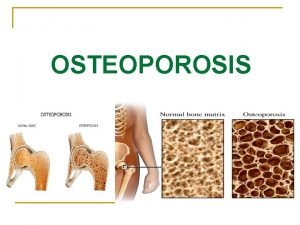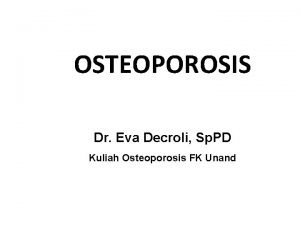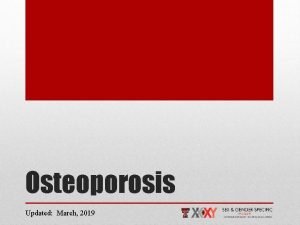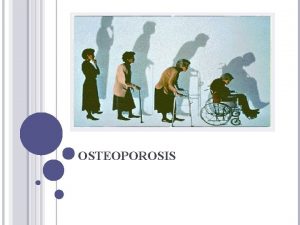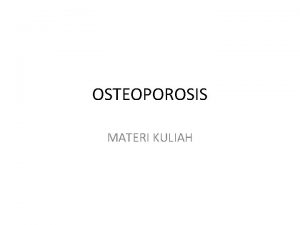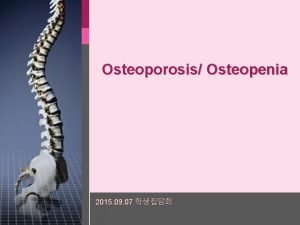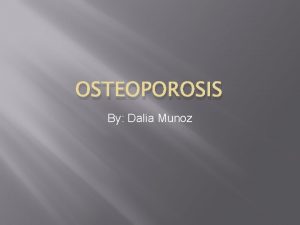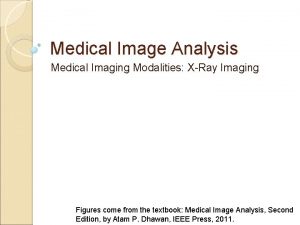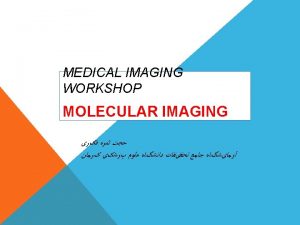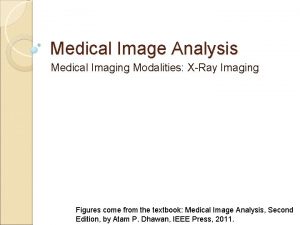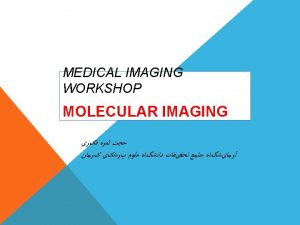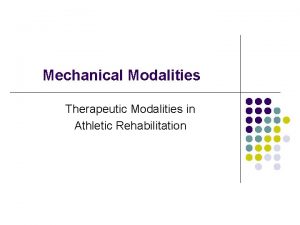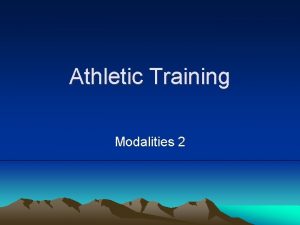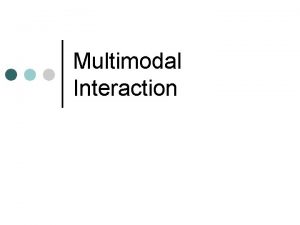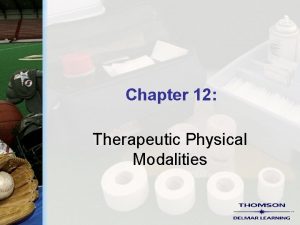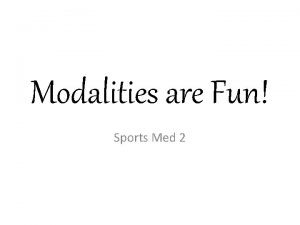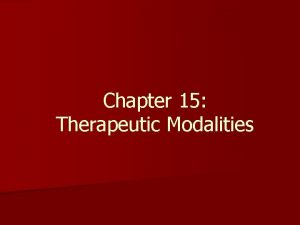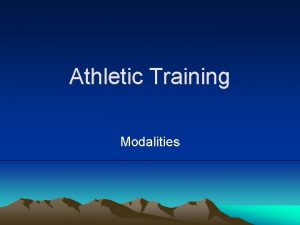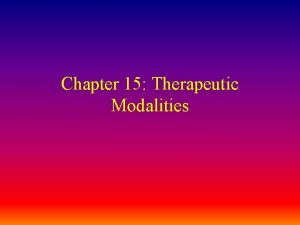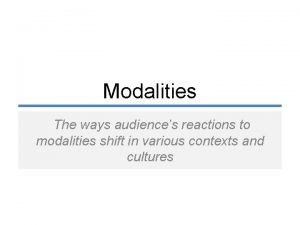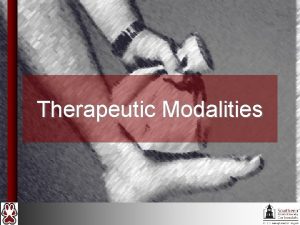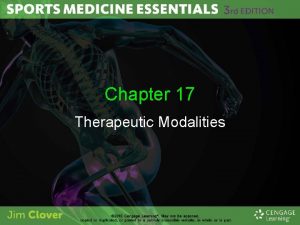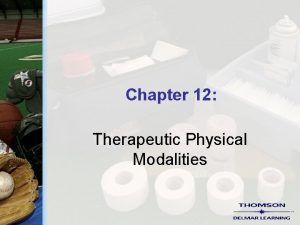Imaging Modalities That Help Diagnos e Osteoporosis C

























- Slides: 25

Imaging Modalities That Help Diagnos e Osteoporosis C 34

• • Objectives • • • Overview Risk Factors Classifications Bony Structures Cause and Development Common sites of Osteoporosis Roles of diagnostic imaging Treatment options Game Conclusion

Thesis Statemen t Osteoporosis affects the deterioration and thinning of cortical and trabecular bone structures, which increases fracture risks for both men and women. 1 This Power. Point will discuss risk factors, treatment options, and different imaging modalities that help diagnose osteoporosis.

Overview • Most common metabolic bone disorder which affects many men and (primarily) women 2 • Defined by low bone mass, deterioration of bone tissues, resulting in rising bone fragility and sensitivity to fractures 2 • x-Ray, DEXA, CT, and MRI help to diagnose Osteoporosis in its early stages 1 https: //www. odtmag. com/contents/view_breaking-news/2017 -06 -23/awareness-adherence-key-to-improved-osteoporosis-care/

• Number of people affected by osteoporosis is more than 200 million worldwide in 2020 (2) Risk Factors • 1 in 3 women and 1 in 5 men over the age of 50 will have an osteoporosis-related fracture in their life 2 • 50% of people who have a hip fracture experience long-term loss of mobility, leaving 25% of those patients to receive long term care 2 • Fractures compromise quality of life due to mobility loss, independence, pain, and stunted lifeexpectancy 2

Classifications of Osteoporosis Primary Osteoporosis Secondary Osteoporosis ❖Cumulative bone loss as people age and undergo sex hormone changes 2 ❖ Results from various medical conditions, diseases, or from certain medications that negatively affect skeletal wellbeing 2 ❖Type 1 Primary: Postmenopausal, 5065 years of age 2 ❖Type 2 Primary: Senile/Elderly 2 ❖ Contributors to secondary (alcoholism, lifetime low diet in vitamin D, celiacs disease) 2

Bone Structures Osteoporosis affects the deterioration and thinning of cortical and trabecular bone structures, increasing fracture risk 2 https: //www. cancervic. org. au/cancer-information/types-of-cancer/bone_cancer/primary-bone-cancer-overview. html

• Bones stabilize our body Bony Composition • • • Collagen 40% Hydroxyapatite 45% Water 15%2 • Bone remodeling is imperative for healthy bones because it rehabilitates any microfractures caused from repeated stresses through the removal of old bone and the building of new bone 3 • Bone remodeling happens through osteoblasts (form bones) and osteoclasts (break bones down) 3

• Peak bone mass is reached at the age of 30 and breaks down by the age of 50 until end of life 3 Etiopathogenesis • Calcium intake during adolescence, sex hormone status, nutrition, physical activity, and genetic factors, all influence one's peak bone mass 3 • Ethnicity plays a factor 3 • Bone loss develops from an imbalance between the interactions of osteoblasts/osteoclasts 2

Vertebral Compression Fractures • Vertebral Compression Fractures are the trademark of Osteoporosis 2 - T 7 -T 8, T 12 -L 1 • Crushing of the vertebral body anteriorly into a wedge shape • Wedge shapes causes spinal deformity (kyphosis) • Ribs push into internal organs causing pressure/discomfort 2

Common Sites of Osteoporosis • Femoral neck • Intertrochanteric region of femur • Spine • Hip fractures cause the greatest morbidity and mortality 2 https: //www. researchgate. net/figure/Anatomic-regions-relating-to-areas-of-proximal -femoral-fractures_fig 1_254506497

https: //www. bsrphysicaltherapy. com/2019/07/22/osteoporosis-back-strengthening-exercises/

Role of Diagnostic Imaging • • Conventional Radiography DEXA (Bone Density Scan) Quantitative CT MRI https: //www. cancerresearchuk. org/about-cancer/cancerin-general/tests/ct-scan https: //www. mydr. com. au/tests-investigations/mri-scanmagnetic-resonance-imaging https: //www. mydr. com. au/tests-investigations/ct-scan-computed-tomography-imaging

Conventional Radiography • Osteoporosis is most commonly diagnosed using x-Ray 2 • x-Ray only detects osteoporosis when there has been a significant amount of bone deterioration/thinning 2 • Technical factors selected & soft tissue thickness creates variable in diagnosis of osteoporosis (2) • Radiographic features appear with increased radiolucency of bone 2 https: //www. sciencesource. com/archive/X-Ray-Showing-Severe-Osteoporosis-SS 2342018. html

Bone Density Scan (DEXA) • Gold Standard for diagnosis • DEXA scanner parts: - x-ray source beneath pt. - couch for patient to lay on - detection system above system 2 • x-Ray beam has two consistencies 2 • Scans in rapid sequence totalling 3 -5 mins 2 • Computer algorithms used for determining bone mineral density 2 https: //www. nof. org/patients/diagnosis-information/bone-density-examtesting/

Bone Density Scan (DEXA) Cont'd • New scanners have lateral scanning which is performed using c-arm rotated 90 degrees 2 • Beneficial with measurement 2 http: //caresi. rezon. co/osteoporosis-t-score-chart/

DEXA Cont’d Advantages ● ● Low radiation dose Low cost Ease of use Rapidity of measurement 2 Disadvantages ● It’s only 2 D ● Cannot distinguish between cortical and trabecular bone 2

Similar to DEXA but it is able to determine trabecular vs cortical bone densities in 3 D 2 Quantitative CT Scan • Initial scout radiograph of the vertebrae 4 • 8 -10 mm slices obtained through the midplane of each vertebrae 4 • An ROI is placed in the anterior portion of the trabecular bone in the vertebral body to be analyzed 4 • CT software locates vertebral body and maps its outer edges 4 • A comparison of CT attenuation of trabecular bone with the calibration standard makes it possible to achieve to bone mineral equivalent 4 • Results are expressed in the form of Z and T scores ike in DEXA scans 4

Advantages of CT • Excellent at predicting vertebral fractures 4 • Can assess trabecular vs cortical bone structures 4 • Exclusion of measurement of structures that are not part of spine but yet contribute to BMD values 4 • 3 D Resolution helps to create better spatial resolution leading to better detail 4 • Best visualization of spines and hips 4 https: //www. minclinic. ru/connecting_eng/osteoporoz_eng. html

MRI • Uses strong magnetic field and a sequence of radiofrequency pulses to make 3 D images 5 • Bone marrow fat can be measured 5 • Vertebral marrow fat content is significantly higher when someone has Osteoporosis 5 • Trabecular bone itself is not visualized, contrary, it is shown through the marrow visualized and appears as a void surrounded by high signal intensity fatty bone marrow 2 • Can distinguish between acute and chronic fractures of vertebrae and stress fractures of proximal femur 2 https: //www. researchgate. net/figure/Sagittal-MRI-of-spine-showing-multiple-compression-fractures-as-a-result-of_fig 1_6976495

MRI Cont’d Advantages Disadvantages • Non-ionizing modality 5 • More costly 2 • It is promising in monitoring treatment effects 5 • Produces lower spatial resolution than CT 2 • Long acquisition time required for exam (difficult and painful for pts) 2 • Artifacts tend to cause an overestimation of trabecular width 2 • Not a common or part of a daily clinical practice so there are no guidelines for its use 2

• Treatment Options Bisphonates are the most common treatment -put a “brake” on the bone degenerating process 3 - Alendronate (Fosamax) - Risedronate (Actonel) - Ibandronate (Boniva) - Zoledronic acid (Reclast) • • Hormones such as estrogen can prevent and treat osteoporosis 3 Decision making process for candidates: 3 -Preference -Convenience -Adherence to the dosing schedule -Cost, including whether or not the drug is a "preferred" option on your insurance company's list of acceptable medications (formulary) • Make a healthier you!

Comprehension Check -smoking What are some imaging modalities that help diagnosis x-ray, DEXA, CT, Osteoporosis? MRI What do osteoblasts do? Help to build new bones What are some - alcohol common risk -vitamin D factors that cause -aging -medications Osteoporosis? bisphonates What are the most hormones common treatments for Osteoporosis? surgery -diseases What is cortical bone tissue? Compact bone -outer surface of the bone What. Vertebrae are common t 7 -t 8, t 11 -t 12 fracture sites of femoral neck Osteoporosis? hip fractures

Conclusion Osteoporosis affects many aging people throughout the world. There are preventative steps one can take to increase their likelihood of maintaining healthier bone structures later in life like routine exercise, routine high calcium intake, and low tobacco/alcohol usage. 3 Treatment options are available to someone who is diagnosed with osteoporosis like bisphonates. 3 Imaging modalities like x-Ray, CT, DEXA, and MRI can help with early detection of osteoporosis. 1

References 1. Osteoporosis. (2019, July 1). Retrieved December 29, 2019, from https: //www. radiologyinfo. org/en/ info. cfm? pg=osteoporosis website: https: //www. radiologyinfo. org/en/info. cfm? pg=osteoporosis 2. Guglielmi, G. , Muscarella, S. , & Bazzocchi, A. (2011, September 6). Integrated imaging approach to osteoporosis: State-of-the-art review and update. Radio. Graphics, 31(5). https: //doi. org/10. 1148/ Rg. 315105712 3. Osteoporosis. (1998 -2020). Retrieved December 29, 2019, from Mayo Clinic Patient Care & Health Information Osteoporosis website: https: //www. mayoclinic. org/diseases-conditions/osteoporosis/ symptoms-causes/syc-20351968 4. Genant, H. K. , Engelke, K. , & Prevrhal, S. (2008). Advanced CT bone imaging in osteoporosis. Rheumatology (Oxford), 47(4), iv 9 -iv 16. https: //doi. org/10. 1093/rheumatology/ken 180 5. Bethel, M. (2019, September 26). Osteoporosis workup. Retrieved January 5, 2020, from Medscape website: https: //emedicine. medscape. com/article/330598 -workup#c 14
 Tackykard
Tackykard Diamant diagnos aritmetik
Diamant diagnos aritmetik Frc driver station mac
Frc driver station mac Superficial and deep heating modalities
Superficial and deep heating modalities Mechanical modalities
Mechanical modalities Therapuetic modalities
Therapuetic modalities Physical modalities
Physical modalities Chapter 40 musculoskeletal care modalities
Chapter 40 musculoskeletal care modalities Thermal modalities
Thermal modalities Tôn thất thuyết là ai
Tôn thất thuyết là ai Thơ thất ngôn tứ tuyệt đường luật
Thơ thất ngôn tứ tuyệt đường luật Gây tê cơ vuông thắt lưng
Gây tê cơ vuông thắt lưng Phân độ lown
Phân độ lown Walmart thất bại ở nhật
Walmart thất bại ở nhật Sau thất bại ở hồ điển triệt
Sau thất bại ở hồ điển triệt Premature atrial contraction
Premature atrial contraction Con hãy đưa tay khi thấy người vấp ngã
Con hãy đưa tay khi thấy người vấp ngã Tìm vết của đường thẳng
Tìm vết của đường thẳng Thơ thất ngôn tứ tuyệt đường luật
Thơ thất ngôn tứ tuyệt đường luật Nursing diagnosis of osteoporosis
Nursing diagnosis of osteoporosis God bone
God bone Osteoporosis
Osteoporosis Osteoporosis t scores
Osteoporosis t scores Woc osteoporosis
Woc osteoporosis Osteoporosis definition
Osteoporosis definition Osteoporosis
Osteoporosis
